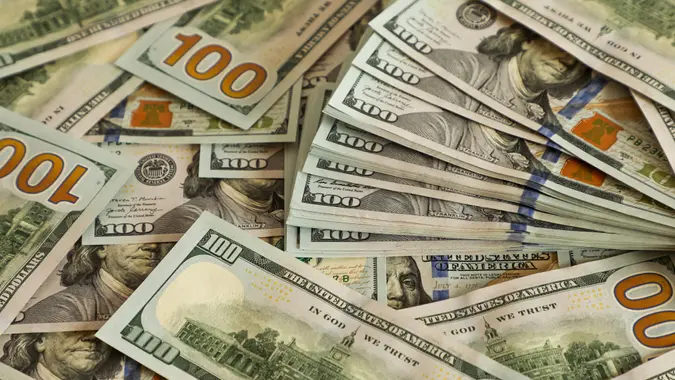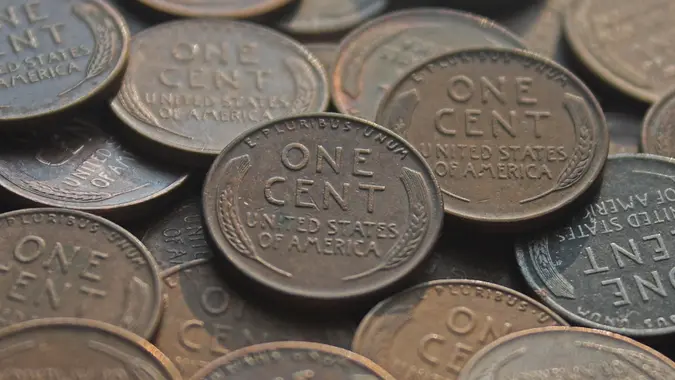Non-Current Assets Explained

Commitment to Our Readers
GOBankingRates' editorial team is committed to bringing you unbiased reviews and information. We use data-driven methodologies to evaluate financial products and services - our reviews and ratings are not influenced by advertisers. You can read more about our editorial guidelines and our products and services review methodology.

20 Years
Helping You Live Richer

Reviewed
by Experts

Trusted by
Millions of Readers
A balance sheet offers a glimpse into a company’s assets and breaks them into two categories: current and non-current assets.
Current assets like cash equivalents and securities can easily be converted into cash. Non-current assets are also important for any company, but these assets take more than a year to convert into cash. They are long-term investments, while current assets represent short-term investments that can quickly turn into cash.
Types of Non-Current Assets
Non-current assets take much longer to turn into cash, and most businesses aren’t in a rush to part ways with non-current assets. Equipment, properties and vehicles are some non-current assets that can help businesses grow.
However, non-current assets also extend beyond tangible assets. Some intangible assets like patents and goodwill also count as non-current assets. You can’t readily convert them into cash, and they provide meaningful value for the company.
Why Non-Current Assets Are Important for Business
Non-current assets are fundamental investments that allow companies to operate smoothly. Many businesses rely on properties and equipment to deliver products and services to their customers. Without these non-current assets, many companies wouldn’t be able to operate. A good lineup of non-current assets makes it easier for a company to generate revenue in the long run.
Accounting for Non-Current Assets
Non-current assets are listed on a company’s balance sheet. Businesses do not list the entire non-current asset’s value as an expense for accounting purposes. Instead, companies record each non-current asset’s depreciation and include that as an expense.
Depreciation Methods for Non-Current Assets
Depreciation reflects the wear and tear an asset endures over time. Once an asset fully depreciates and reaches its salvage value, a business can no longer accumulate depreciation expenses for that asset. Companies calculate depreciation with one of the following methods:
Straight-Line
This straightforward method results in the same depreciation expense every year until an asset reaches its salvage value. Businesses deduct an asset’s anticipated salvage value from its cost and divide the difference by its useful life. Useful life measures how many years an asset takes to reach salvage value.
Assume a $10,000 asset will reach a $1,000 salvage value after five years.
- Cost of asset = $10,000
- Salvage value = $1,000
- Useful life = 5 years
- Straight-line depreciation = ($10,000 – $1,000) / 5
- Straight-line depreciation = $9,000 / 5
- Straight-line depreciation = $1,800 per year for five years
Declining Balance
Some businesses front load depreciation expenses by accelerating this expense at the beginning of an asset’s existence.The declining balance method works well for assets that quickly lose value, such as cars and computers.
Here’s the formula:
Declining balance depreciation = Current book value x depreciation rate
The depreciation rate is always expressed as a percentage, which means depreciation expenses will be the highest in the beginning.
Sum-Of-The-Years’ Digits
The sum-of-the-years’ digits depreciation method is a hybrid of straight-line and declining balance appreciation methods. Sum-of-the-years’ digits still depreciates an asset quicker than straight-line, but it’s not as dramatic as declining balance.
Here’s the formula:
Sum-of-the-years’ digits depreciation = (Remaining lifespan/SYD) x (asset cost – salvage value)
Here’s how the formula would work if a $5,000 asset reaches its $1,000 salvage value in three years. This formula is for the asset’s first year.
- Sum-of-the-years’ digits depreciation = (3/6) x ($5,000 – $1,000)
- Sum-of-the-years’ digits depreciation = 0.50 x $4,000
- Sum-of-the-years’ digits depreciation = $2,000
SYD is six because the asset has a three-year window. 3 + 2 + 1 =6, hence its name as “sum-of-the-years’ digits.”
Units of production
The units of production depreciation method focuses on the units produced as its depreciation method. That means an asset will lose value quicker if it produces more units. However, assets that do not produce many units haven’t gone through as much wear and tear, resulting in higher values.
Here’s the formula:
Units of production depreciation = [(Asset cost – salvage value) / estimated lifetime units] x actual units made
Assume a non-current asset is valued at $2,000 and has a salvage value of $200. It can produce 10,000 units over its lifetime and has already produced 1,000 units. Here’s how you could calculate the depreciation expense with the units of production formula:
- Units of production depreciation = {($2,000 – $200) / 10,000] x 1,000
- Units of production depreciation = ($1,800/10,000) x 1,000
- Units of production depreciation = 0.18 x 1,000
- Units of production depreciation = $180
Valuation of Non-Current Assets
Each non-current asset’s value starts at the purchase price. However, its valuation will gradually decline as it incurs depreciation. If you bought a non-current asset for $10,000 and have written off $3,000 for depreciation, the current valuation of that non-current asset is $7,000.
Examples of Non-Current Assets in Major Companies
UPS relies on many non-current assets to serve its customers. The company released a year-end balance sheet for 2023 that detailed how its capital is spread across non-current assets.
Property, plant, and equipment represented the largest non-current asset and was valued at $36.9 billion. The company also had $11.8 billion worth of vehicles and aircraft, which reached a total valuation of $22.9 billion. UPS purchased an additional $309 million in property, plant, and equipment in 2023.
Walmart also lists property and equipment as its top non-current asset, which totaled $113,8 billion in the second quarter of the fiscal year 2024. Goodwill came in at $27.9 billion, which represents a slight year-over-year reduction from the $28.3 billion figure posted in the Q2 FY24.
Non-Current Assets and Business Strategy
Businesses acquire non-current assets to increase their capacity to serve customers. Buying more vehicles allows UPS to expand its market share. Walmart’s numerous facilities allow it to provide one-day or same-day shipping in many parts of the United States. These non-current assets allow UPS and Walmart to deliver levels of service that few companies can compete with.
Companies can anticipate long-term demand trends and acquire or sell non-current assets to reflect those trends. For instance, UPS can buy more vehicles if it anticipates more people will buy products online. Walmart can open stores in new areas that are seeing population growth. How companies buy non-current assets and position them plays a role in their total market share and long-term growth trends.
How Non-Current Assets Impact Investors and Shareholders
Non-current assets impact a company’s long-term financial growth and its ability to compete in the industry. Since non-current assets impact a company in significant ways, they also impact investors and shareholders.
Good non-current assets can lead to more financial growth, which will push the stock price higher. However, unproductive non-current assets will have the opposite effect and can hurt the stock price.
If non-current assets continue to underperform, a company may have to sell some of its non-current assets and give up market share. Companies that can continue to acquire non-current assets while keeping up with current liabilities can put investors and shareholders in a favorable position.
FAQ
- What are examples of non-current assets?
- Commercial properties, equipment and goodwill are some examples of non-current assets. They are long-term investments that can't easily be converted into cash.
- What are non-current and fixed assets?
- Non-current and fixed assets are long-term investments on a company's balance sheet. These assets help companies generate revenue. Cash flow that comes from non-current and fixed assets goes toward current liabilities and other costs.
Our in-house research team and on-site financial experts work together to create content that’s accurate, impartial, and up to date. We fact-check every single statistic, quote and fact using trusted primary resources to make sure the information we provide is correct. You can learn more about GOBankingRates’ processes and standards in our editorial policy.
- Walmart. 2024. "Walmart Reports Second Quarter Results."
- UPS. 2023. "Annual report pursuant to Section 13 and 15(d)."
 Written by
Written by  Edited by
Edited by 
























